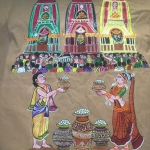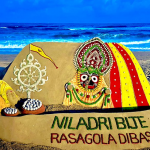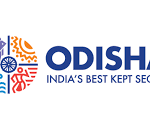 By Dr. Anita Sabat in Bhubaneswar, July 17, 2024: Today is Niladri Bije. Today’s date is 19th July. Does this day or date have any significance for an average Odia?
By Dr. Anita Sabat in Bhubaneswar, July 17, 2024: Today is Niladri Bije. Today’s date is 19th July. Does this day or date have any significance for an average Odia?
When will any date have any significance for us? When it is linked with someone or something dear to us. Thus, birthdays and anniversaries have special importance and meaning. There is at least some celebration on the significant day.
What is so sweet and special about this year’s Niladri Bije and 19th July for Odisha? Many do not know that these are linked with our Odisha’s centuries-old invention- Rasagola, and Ratha Jatra 2024. Why should we even bother about days and dates? Do we even need to celebrate?
If we bother and care, and celebrate and share, then others will also get to know and they will be aware, and in turn care, celebrate, and share. This is a chain reaction.
Let’s face this fact- Many in India are yet to know that the Rasagola belongs to Odisha. Many are yet to even taste Odisha’s Rasagola. In Odia, it is said- “Ratha Jatra jebethu, Rasagola sebethu”- Rasagola is as old as the Ratha Jatra.
Rasagola has always been synonymous with Odisha’s dominant and more vocal neighbour. In the national media, it is even spelled as “Rosogolla/Rossogolla/Roshogolla/Rasogolla etc” to emphasise on their style and pronunciation, and thus ownership.
How do people know something? Information needs to reach them and they need to experience, be told, shown, and made aware.
Niladri Bije And Rasagola
Let us take Niladri Bije, Ratha Jatra, and Rasagola for example.
Niladri Bije is being celebrated today, and with that the Ratha Jatra 2024 will come to a close. ‘Niladri’ refers to the Shree Jagannatha Temple and ‘Niladri Bije’ means ‘arrival of the God’. The Shree Jagannatha Temple is called the ‘Shreemandira’. ‘Shree’ refers to Maa Lakshmi. This shows the importance of Maa Lakshmi. Rasagola has been traditionally offered as bhoga to Goddess Lakshmi (Sridevi) at the Shree Jagannatha Temple at Puri on Niladri Bije.
Goddess Lakshmi gets upset because Her husband, Mahaprabhu Shree Jagannatha, goes on Ratha Jatra, to His birthplace, the Shree Gundicha Temple. He goes with His siblings and without taking Her along. After the Ratha Jatra, when it is time for the deities to re-enter the temple on Niladri Bije, She allows Shree Balabhadra, Devi Subhadra and Shree Sudarshan to enter. However, She does not allow Mahaprabhu to enter. The divine couple has a ritualistic conversation that is called ‘Lakshmi Narayana Bachanika’. This verbal fight is also called ‘Lakshmi Narayana Kali’.
To placate Goddess Lakshmi, i.e. for ‘Manabhanjana’, Shree Jagannatha offers Her Rasagolas. This meeting and episode involving the divine couple evokes special interest and statement. This is Mahaprabhu’s “manabiya leela” with the human touch and elements. As on Niladri Bije, Rasagola appeases Goddess and does Manabhanjana, we celebrate Niladri Bije as ‘Rasagola Dibasa’.
 Each year, on the last day of the Ratha Jatra, the Niladri Bije ritual is systematically conducted, just like the other rituals have been observed at the Shree Jagannatha Temple, Puri, for the past several centuries. Niladri Bije is the day of the year when devotees offer special Rasagola bhoga to Shree Jagannatha. The observance of the sweet offering of Rasagola brings the Ratha Jatra festival to a sweet end.
Each year, on the last day of the Ratha Jatra, the Niladri Bije ritual is systematically conducted, just like the other rituals have been observed at the Shree Jagannatha Temple, Puri, for the past several centuries. Niladri Bije is the day of the year when devotees offer special Rasagola bhoga to Shree Jagannatha. The observance of the sweet offering of Rasagola brings the Ratha Jatra festival to a sweet end.
But, before 2015, how many Odias were aware of this tradition that has been continuing for centuries? When Odisha has had continuing tradition and cultural link to substantiate her Rasagola claims, why was there no attempt to share and publicize and change the incorrect public perception about Rasagola?
I know about Rasagola’s cultural link with Odisha thanks to my mother. But, how many Odia parents know/knew about this and consider it important to be shared with their children? How many books have this information?
To share about the glory and story of Rasagola, in the year of the Nabakalebara Ratha Jatra 2015, this writer first proposed and initiated celebration of Niladri Bije as Rasagola Dibasa through a series of tweets, blogs, and social media posts starting March 18, 2015. There was planning, preparation, facilitation and bring all together and soliciting everyone’s participation. The idea was that celebration of a day for Rasagola can make people aware about Rasagola’s association with Odisha. Many joined and we collectively shared information online using the hashtag #RasagolaDibasa.
Owing to the involvement and participation of many swabhimaani Odias on the Niladri Bije of the Nabakalebara Ratha Jatra on July 30, 2015, hashtag- #RasagolaDibasa trended on Twitter.
Thus, on the same day and many months following our celebration and till date, there have been many news-reports, articles, discussions, and debates regarding Rasgulla “origin” and to “which state” the Rasgulla “belongs”.
Owing to the online war, the Bengal and Odisha Governments both set up committees and there was Rasagola research, and consequently both the states filed for their respective Geographical Indication (GI) tags- namely- ‘Banglar Rasogolla’ and ‘Odisha Rasagola’; and now both products are registered GIs of India.
 Many leading media published op-ed pieces starting from the first Rasagola Dibasa- July 30 2015 onwards and shared that- “Odisha is the birthplace of the Rasagola”. Expert food-historian and writer, Prof Pushpesh Pant too researched and shared about Rasagola’s Odisha origin.
Many leading media published op-ed pieces starting from the first Rasagola Dibasa- July 30 2015 onwards and shared that- “Odisha is the birthplace of the Rasagola”. Expert food-historian and writer, Prof Pushpesh Pant too researched and shared about Rasagola’s Odisha origin.
How many columns about Rasagola had been published in the media before 2015?
Though we had started the Rasgulla Day celebration on social media to end the debate about Rasagola #EndRasgullaDebate, yet even today, misinformation regarding Chhena and Rasgulla “invention” continues. In fact, celebration of Rasagola Dibasa led to misinformation too as people shared and are still sharing what (wrong information) was/is available online, without knowing or verifying. Odisha’s name is not mentioned in articles or videos about Rasgulla or GI tag as most mention Rasgulla as a “Bengali sweet”.
The information provided and published in many articles and reports needs to be reviewed by experts, and correct information must be shared and updated.
Misinformation About Chhena Invention & Bhoga
Many still erroneously believe-
A) The Portuguese taught Indians how to prepare Chhena (cottage-cheese)!
B) Chhena is not a part of temple food as it is considered “impure” and not offered to Gods.
C) Only Chhappan Bhog (56 varieties of offerings) are offered in the Shree Jagannatha Temple.
D) Rosogolla/Rasgulla belongs to Bengal; Khiramohana belongs to Odisha and Khiramohana is offered in the Shreemandira.
E) Rosogolla is white; Khiramohana (what Odisha now calls Rasagola) is brown!
They are yet to know or accept that-
• Chhena has been a part of Mahaprabhu Shree Jagannatha’s Mahaprasad for centuries. The Portuguese came much later.
• Many dishes made of Chhena like Rasagola, Rasabali etc have been a part of the Bhoga Khetra- Puri, one of the Chaar Dhaams of India for centuries.
• Puri is the Dhaam where Mahaprabhu eats. Thus, there are more than a hundred varieties of dishes, and not just limited to fifty-six in number i.e. Chhappan Bhog.
• Rasagola and NOT Khirmohan/Khiramohana is the bhoga/prasad on Niladri Bije of Ratha Jatra.
Odisha Rasagola is available in multiple colours including white and different shades, and not just ‘brown’.
Bhitarachha Mohapatra is the sebayat of the Shree Jagannatha Temple, who prepares Rasagola for the Niladri Bije ritual. Five years ago, when this writer asked him about Khiramohana, he expressed his ignorance and said he had never even heard of the word! Eminent writer and researcher, Sri Surendra Mishra, and Shreemandira sebayat Sri Biswanath Samantara state that Khiramohana is a different sweet that is not linked to the Shreemandira.
However, owing to the incorrect information available online, there are many myths about Rasagola.
Now for the significance of some of the dates-
July 30- It was the year of the Nabakalebara Ratha Jatra 2015 when we first celebrated the maiden Rasagola Dibasa online on Niladri Bije that was on July 30 that year.
July 29—Our relentless efforts starting in 2015 ensured Odisha earned the Geographical Indication (GI) tag on July 29, 2019. This year, 2024, marks the fifth anniversary of this sweet event.
July 19 2024- The date of Niladri Bije this year marks the tenth celebration of Rasagola Dibasa.
Rasagola Dibasa celebration has created awareness and instilled pride. Due to Rasagola Day celebration on Niladri Bije, the people who previously never offered Rasagola bhoga, did not know about the culture, did not write a single word or line about Rasagola or GI tag, are now aware, vocal, and demanding GI tags. Many have started adopting handlooms and local products too. Pahala Rasagola sweetmakers wear Odisha Ikat like Khandua and Sambalpuri Bandha for events like the ‘Odisha Parba’. Odisha has more local ‘experts’ and ‘spokespersons’ now.
 Some people have also become entrepreneurs and started Rasagola and other Odisha products’ business. While there was no specific Odia song and movie dedicated to Rasagola earlier, since 2015 many Rasagola songs and movies have been presented. Before the Rasagola war, Odisha had 14 GI tags, now we have 26. However, simply earning the GI tag is not enough; post-GI initiatives and sustained efforts are needed.
Some people have also become entrepreneurs and started Rasagola and other Odisha products’ business. While there was no specific Odia song and movie dedicated to Rasagola earlier, since 2015 many Rasagola songs and movies have been presented. Before the Rasagola war, Odisha had 14 GI tags, now we have 26. However, simply earning the GI tag is not enough; post-GI initiatives and sustained efforts are needed.
We need to provide the best quality, ensuring hygiene, good packaging, and the availability of Rasagola worldwide. The GI logo and tagline need to be used. More GI Authorised Users (AUs) have to be registered to use the GI Tag. In Hindi, it is said- “Jo dikhta hi, wo bikta hai.” Also, “Jo bikta hai, wo dikhta hai.”. It means: What is seen sells. What sells is seen.
Rasagola is linked with Shree Jagannatha culture and Brand Odisha. We must promote and celebrate Brand Rasagola. We must all be “vocal for local” and “vocal for GI” brand ambassadors and ensure that our Odisha Rasagola reaches the global market. Whenever the word ‘Rasagola’ or ‘Rasgulla’ is used, ‘Odisha’, ‘Ratha Jatra’, ‘Niladri Bije’, and ‘Mahaprabhu and Maa Lakshmi’ must come to the mind. Only then, Odisha state’s stakeholders, culture, and truth will emerge victorious in the “Rasagola sweet war”.


Leave a Reply
Be the First to Comment!